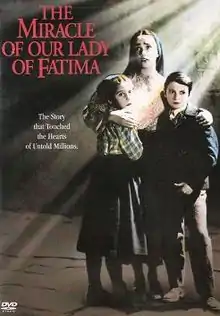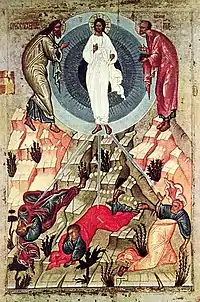The Miracle of Our Lady of Fatima
The Miracle of Our Lady of Fatima is a Warner Color feature film made in 1952.[1] It was promoted as a fact-based treatment of the events surrounding the apparitions of Our Lady of Fátima, in Portugal, in 1917.[2][3][4]
| The Miracle of Our Lady of Fatima | |
|---|---|
 DVD cover | |
| Directed by | John Brahm |
| Produced by | Bryan Foy |
| Written by | James O'Hanlon Crane Wilbur |
| Starring | Susan Whitney Sherry Jackson Sammy Ogg Gilbert Roland |
| Narrated by | Walter Hampden |
| Music by | Max Steiner |
| Cinematography | Edwin B. DuPar |
| Edited by | Thomas Reilly |
| Distributed by | Warner Bros. |
Release date |
|
Running time | 102 min |
| Language | English |
| Part of a series on |
| Christian mysticism |
|---|
 |
It stars Susan Whitney as Lúcia dos Santos, Sherry Jackson as Jacinta Marto and Sammy Ogg as Francisco Marto, with Gilbert Roland as a fictional character named Hugo, a kindly but agnostic friend of the three children, who rediscovered his faith in God through the Miracle of the Sun. The musical score by Max Steiner received an Academy Award nomination. The film was released on DVD on April 4, 2006.
Plot
It is 1917. Portugal is feeling the after-effects of a storm of anti-religious sentiment and the violent overthrow of the monarchy and the government in the 5 October 1910 revolution. Churches in Lisbon and the rest of Portugal are boarded up. Many priests, nuns, monks and friars are shown being fingerprinted, photographed and registered as possible criminals before being jailed. The rural town of Fátima is small enough to have escaped much of this persecution; their church remains open, and most of the people are reasonably devout.[5]
Watching their flocks and playing in a field outside town on May 15 (the actual date of the first apparition was May 13), Lúcia Santos (Susan Whitney) and her cousins, Jacinta Marto (Sherry Jackson) and Francisco Marto (Sammy Ogg) decide to pray their version of the Rosary by yelling out, "Hail Mary!" but not finishing the prayer. In the midst of this activity they hear a clap of thunder and see a flash of lightning from a distance. Thinking it is about to rain, the children gather their sheep and head for their homes. Another flash of lightning causes them to run straight into an unusual "cloud of light" surrounding a little tree on which a mysterious lady stands. Speaking slowly and gently, the Lady asks them to return on the 13th of each month and to offer their sufferings to God for the salvation of sinners. She entreats them to say the Rosary for world peace. Later, they encounter their agnostic friend Hugo (Gilbert Roland) who tells them it is best not to reveal the vision to anyone else, but of course on returning home, Jacinta immediately divulges her sightings.
Jacinta and Francisco's parents quickly believe the story, but Lúcia's mother reacts with disgust and subjects her daughter to emotional and physical mistreatment. She forbids Lúcia to return to the Cova da Iria, but Lúcia does so anyway on the next month's appearance (June 13), and is told then that her cousins will die and go to heaven "soon", while she will live a long life in holy service. The parish priest suggests the visions might be from Satan. The local authorities close the Fátima church until the priest can convince the parishioners that no visions have or will happen. The next month, on July 13, the Lady appears again, predicting "another and worse war" (World War II) will happen if the world doesn't stop sinning. She also predicts evil will come from Russia if that nation is unconverted. Kidnapped by provincial administrator Artur Santos (who is not related to Lúcia Santos), the children are first offered bribes, then threatened with death if they don't change their story. Trying to frighten them, he has first Jacinta, then Francisco dragged into another room. Jacinta's terrified screams convince Lúcia that her cousins are dead, but she refuses to deny what she's seen. Warning her that she's about to experience "the full treatment", Artur Santos reunites her with her cousins, who are alive, then throws them all in jail. There they find Hugo, who stands by them as they convince all the prisoners to join in the Rosary.
Unable to find any prosecutable evidence, Artur (Frank Silvera) frees the children, who find that the entire population of Fátima has been standing outside waiting for them.
On October 13, when the Lady promised "a sign that will make them believe", about forty thousand people arrive, waiting through a torrential downpour. The Lady appears and says that the war (World War I) will be over soon and the soldiers will be returning to their homes. At precisely noon, as the Lady raises her hands, the clouds part and the sunlight shines brightly upon all the people—then the Sun shifts through a rainbow of colours and appears to move closer, in what many have described as the Miracle of the Sun. Many people panic, some pray or watch calmly, and a few sick and disabled people are healed. As the Sun returns to normal, Hugo stands in the middle of the kneeling crowd, his hat still on. Removing it, he says "Only the fool sayeth there is no God."
A short epilogue, circa 1951, shows the huge basilica where the tree once stood and a million people outside paying homage to Our Lady of Fátima. At the end of the film, inside the new basilica (where the Cova da Iria once was), Lúcia is now a nun praying before the tomb where her cousins are buried, with the converted Hugo at her side.
Cast
- Susan Whitney as Lúcia dos Santos
- Sherry Jackson as Jacinta Marto
- Sammy Ogg as Francisco Marto
- Gilbert Roland as Hugo da Silva
- Angela Clarke as Maria Rosa dos Santos
- Jay Novello as António dos Santos
- Frank Silvera as Arturo dos Santos
- Richard Hale as Father Ferreira
- Norman Rice as Manuel Marto
- Frances Morris as Olímpia Marto
- Carl Milletaire as District Magistrate
- J. Carroll Naish as Narrator
- Ethan Laidlaw as Villager (uncredited)
- Jack Mower as Villager (uncredited)
See also
References
- Malone, Peter (2019). Screen Priests: The Depiction of Catholic Priests in Cinema, 1900-2018. ISD LLC. ISBN 9781925872927. Retrieved 15 November 2019.
- Bernardi, Daniel; Green, Michael (2017). Race in American Film: Voices and Visions that Shaped a Nation [3 volumes]. ABC-CLIO. p. 57. ISBN 9780313398407. Retrieved 15 November 2019.
- Sterritt, David; Anderson, John C. (2008). The B List: The National Society of Film Critics on the Low-Budget Beauties, Genre-Bending Mavericks, and Cult. Hachette Books. ISBN 9780786726509. Retrieved 15 November 2019.
- O'Brien, Catherine (2011). The Celluloid Madonna: From Scripture to Screen. Columbia University Press. p. 23. ISBN 9780231501811. Retrieved 15 November 2019.
- Newberry, George (2007). The Devil's Reign: A Documented True Story That Proves the Forces of Good and Evil Do Exist. AuthorHouse. p. 222. ISBN 9781463493011. Retrieved 15 November 2019.
The Miracle of Our Lady of Fatima 1952 film.
External links
| Wikiquote has quotations related to: The Miracle of Our Lady of Fatima |
